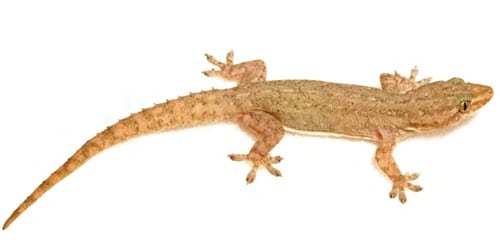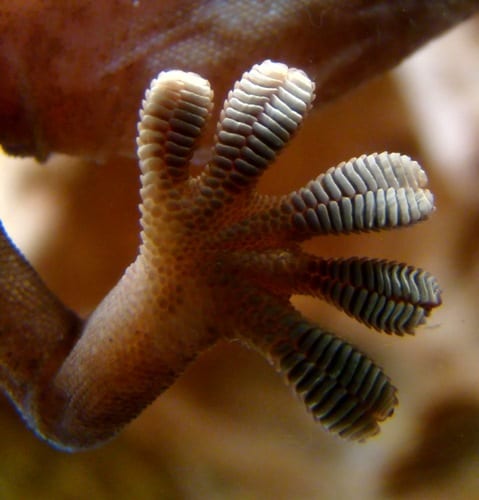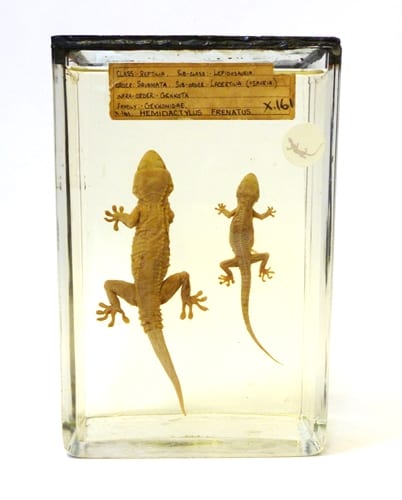Specimen of the Week 308: the geckos
By Will J Richard, on 15 September 2017
Hello! Will Richard here, picking another specimen for you. And this week I’ve chosen a slick, little lizard that actually lives up to its name: there are lots of them and they live in buildings. That’s right folks it’s not the rare and only found outside gecko, it’s the…
common house gecko
City living
Common house geckos (Hemidactylus frenatus) are 15 centimetre reptiles originally native to Southeast Asia but now found throughout tropical and subtropical regions worldwide. “Naturally” they live in a range of habitats that include rainforests, savannahs and deserts. These seemingly have little in common and this adaptability has meant that they also thrive in towns and cities. The adults congregate at night around artificial lights and feed on any insects and spiders which these makeshift traps attract, often climbing walls and hanging from ceilings in their search for food.

Common house gecko adult. Image by Brown et al.; via Wikimedia Commons; CC-BY-SA-3.0
Sticky fingers
Geckos are famous for their ability to climb almost anything, including a perpendicular sheet of glass. To make this possible their toes are covered with ridges and microscopic hairs which greatly increase the surface area of a gecko’s foot. This allows more intermolecular forces to form between foot and wall, which collectively are surprisingly strong and greater than the weight of the lizard.

Gecko foot on glass. Image by Bjorn Christian Torrissen; via Wikimedia Commons; CC-BY-SA-3.0
Hot and cold
Common house geckos lay eggs in small clutches, which hatch after a gestation period of about two months. Interestingly females can store functional sperm within their body and delay fertilisation for up to a year after mating. This presumably allows them to wait until conditions favour the young geckos’ survival. The eggs themselves are small, round and hard-shelled which makes them easy to hide, resistant to desiccation and travel proof. Despite this they need to stay warm (at least 28 degrees Celsius) so females lay all year round in hotter regions and only during the warmer months in colder ones. Like many reptiles the sex of the offspring is not pre-determined genetically but varies according to the ambient temperature of the nest during a critical period about halfway through incubation. A major concern for herpetologists is that as global temperatures increase, the sex ratio of reptile populations will become skewed. This could, theoretically, make continued breeding impossible.

Common house gecko juvenile. Image by Hexasoft; via Wikimedia Commons; CC-BY-SA-3.0
First impressions
It is unusual to be writing a blog about an animal that isn’t threatened in some way, but common house geckos really aren’t. Their adaptable lifestyle and ability to travel huge distances between mating and laying eggs means that they have colonised all of the world that is warm enough, primarily by hiding on boats. And as more of the world becomes warm enough, I’m sure this will continue. In the process they are driving many less tenacious gecko competitors to extinction. They deny them food, habitat and breeding opportunities and also carry two species of red gecko mite. These mites have spread to local gecko populations infecting them with protozoan diseases to which they have no immunity.
References:
Will Richard is Visitor Services Assistant at the Grant Museum of Zoology
 Close
Close


